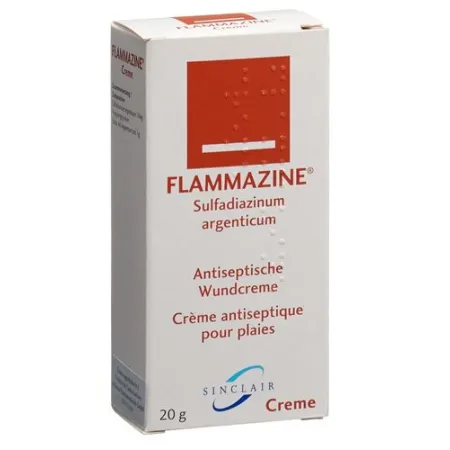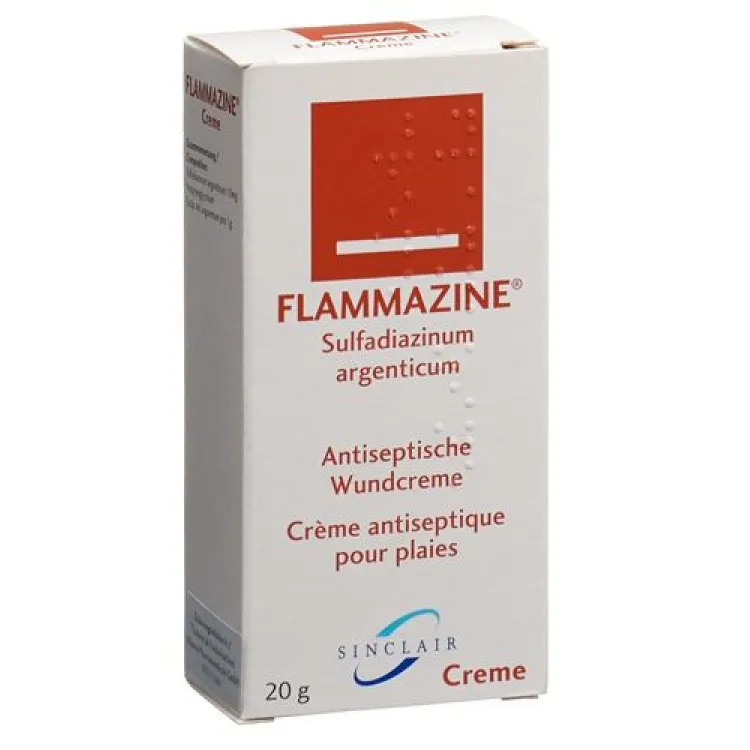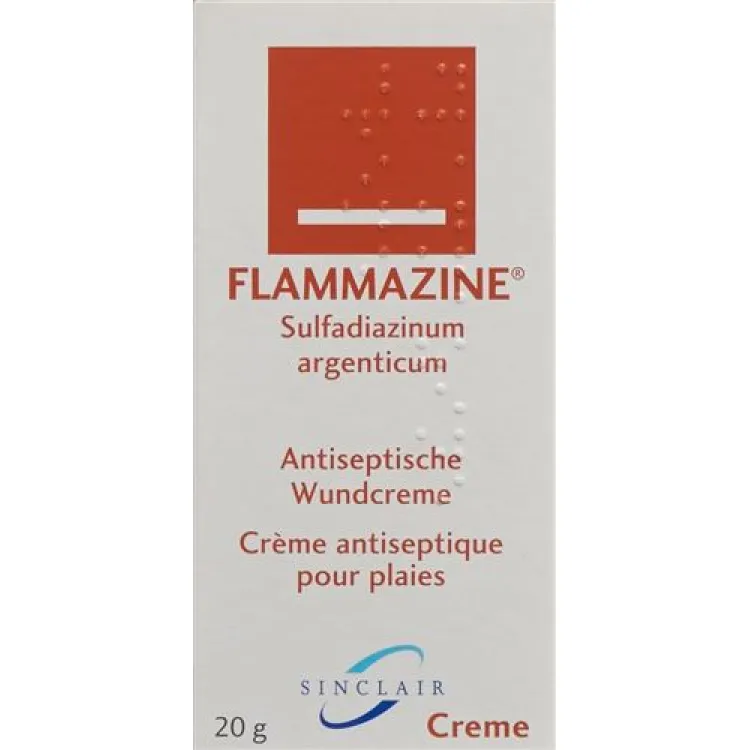Flammazine Cream tube 20 g
Flammazine Cream Tb 20 g
-
27.22 USD

- Availability: In stock
- Distributor: SINCLAIR PHARMA GMBH
- Brand: Flammazine
- Product Code: 1433250
- ATC-code D06BA01
- EAN 7680386070304
Ingredients:
Description
What Flammazine Cream is and what it is used for
The antibacterial activity of Flammazine's Cream sulfadiazine silver active ingredient helps fight various germs found in infected wounds.
Flammazine Cream can be used to treat
-minor burns;
-minor skin infections;
-and minor infected wounds.
Only with a doctor's prescription, Flammazine Cream can be used for the prevention and treatment of skin infections and infected wounds, pressure ulcers (in bedridden patients), leg ulcers and burns of various degrees.
Flammazine Cream does not burn, hurt, stick, stain and is easy to remove.
What precautions should be taken?
Extensive and severe burns, major skin infections, decubitus wounds and leg ulcers all require medical treatment.
Large, heavily soiled and deep wounds, as well as bite and puncture wounds must be treated by a doctor (danger of tetanus). If the size of a wound remains unchanged for some time or if the wound does not heal within 10-14 days, a doctor's visit is also necessary. The same applies if the edges of the wound are very red, the wound suddenly swells, is very painful or the injury is accompanied by fever (danger of blood poisoning).
When should Flammazine Cream not be used?
You must not use Flammazine Cream in the following situations:
-if you are allergic to silver sulfadiazine or any of the other ingredients of this medicine;
- in premature babies and newborns during the first two months of life, as sulfonamides can cause brain damage (kernicterus);
-in the 3rd trimester of pregnancy (last 3 months of pregnancy).
When is caution needed when using Flammazine Cream?
Caution should be exercised in the following situations, use Flammazine Cream only if prescribed by a doctor:
-if you are allergic to sulphonamides;
-if you suffer from severe kidney problems;
- if you suffer from severe liver dysfunction or acute liver inflammation;
- if you suffer from glucose-6-phosphate dehydrogenase deficiency (rare hereditary metabolic disorder which can lead to damage to the red blood cells by various medicines);
-if you suffer from hemoglobin abnormalities (e.g. Hb Cologne or Hb Zurich) or acute porphyria (disorder of the formation of the red blood pigment).
- If you have or have ever had an inflammatory skin disease with blistering (erythema multiforme).
- If you have been diagnosed with a pathological change in the blood count with a reduction in the number of white blood cells (leucopenia).
Under the influence of sunlight, a gray discoloration of the skin can occur due to the accumulation of silver (= argyrose). The parts of the body treated with Flammazine Cream must therefore be protected from the sun and other UV light (sunbathing, tanning salon). The parts of the body treated with Flammazine Cream should be protected, for example by covering them with a sterile, breathable bandage or suitable clothing.
Serious skin reactions (Stevens-Johnson Syndrome (SJS), Toxic Epidermal Necrolysis (TEN), which can be life-threatening, have been reported with the use of Flammazine Cream. These present initially as reddish, target-like or circular patches (often with a blister in the middle) on the trunk of the body The rash can lead to widespread blistering or peeling of the skin.
Additional symptoms to look out for include open, sore spots (ulcers) in the mouth, throat, nose, and genitals, and red and swollen eyes (conjunctivitis). These potentially life-threatening skin reactions are often accompanied by flu-like symptoms (headache, fever and body aches).
The risk of developing SJS or TEN is highest during the first few weeks of treatment. If you have developed Stevens-Johnson Syndrome or Toxic Epidermal Necrolysis associated with the use of Flammazine, you must never be treated with Flammazine Cream again.
If you get a rash or any of the other skin symptoms listed above, stop using Flammazine Cream and see a doctor straight away. Tell him that you are using this medicine.
Long-term or widespread use of Flammazine Cream may increase the likelihood of side effects.
Using Flammazine Cream with other medicines
Tell your doctor, pharmacist or druggist if you are taking/using other medicines, have recently taken/used other medicines or intend to take/use other medicines.
Since a small part of the active substance contained in Flammazine Cream can be absorbed by the body, interactions with other medicines are possible, eg medicines to inhibit blood clotting or to treat diabetes and epilepsy.
The use of Flammazine Cream should be avoided three days before and three days after a typhoid vaccination.
If other creams containing proteolytic enzymes are applied at the same time, the silver component of Flammazine can reduce the effect of the enzymes.
Effect on the ability to drive and use machines
Flammazine Cream has no or negligible influence on the ability to drive and use machines.
Flammazine Cream contains cetyl alcohol and propylene glycol.
These ingredients may cause localized skin irritation and skin reactions (eg contact dermatitis).
Do not use this medicine on extensive skin injuries or damage without consulting your doctor, pharmacist or druggist.
Inform your doctor, pharmacist or druggist if you suffer from other illnesses, have allergies or are taking other medicines (even those you bought yourself!) or using them externally!
Can Flammazine Cream be used during pregnancy or breastfeeding?
Do not use Flammazine Cream during the 3rd trimester of your pregnancy (last 3 months of pregnancy). During the other stages of pregnancy, you should only use Flammazine Cream if prescribed by your doctor.
Do not use Flammazine Cream while breastfeeding unless directed to do so by your doctor. Premature infants and infants with jaundice (yellowing of the skin or the normally white sclera of the eye) or infants with suspected or known glucose-6-phosphate dehydrogenase (a red blood cell metabolism disorder) deficiency should not be breast-fed while using Flammazine Cream .
How do you use Flammazine Cream?
Adult
Flammazine Cream is applied directly to the wound once a day in a 2-3 mm thick layer; it can be covered with a sterile, air-permeable bandage. Wash off old residues of the cream with water or a physiological solution (e.g. 0.9% saline solution).
The duration of treatment depends on the underlying disease. The duration of use is usually 10 to 14 days.
Children and young people under the age of 18
The use and safety of Flammazine Cream in children and adolescents has not yet been tested.
The tube is sealed and has a safety lock. Open the tube and invert the cap and place it on the thread; turn right to open the seal.
Follow the dosage given in the package leaflet or prescribed by your doctor. If you think the medicine is too weak or too strong, talk to your doctor, pharmacist or druggist.
What side effects can Flammazine Cream have?
Like all medicines, this medicine can cause side effects, although not everybody gets them.
Uncommon (affects 1 to 10 users in 1000)
-Skin rash
- Graying of the skin (due to prolonged use or exposure to sunlight)
- Burning and pain at the site of application
-Non-specific symptoms such as fever, severe chills, sore throat or mouth ulcers could be a sign of a blood disorder called leukopenia
Very rare (affects less than 1 in 10,000 users)
- severe and possibly life-threatening skin reactions (Stevens-Johnson syndrome and toxic epidermal necrolysis) have been reported (see chapter «When should caution be used with Flammazine Cream?»)
Not known (cannot be estimated from the available data)
-a rare blood disorder (called methaemoglobinaemia) with symptoms such as pale, gray or blue colored skin, lips and nail beds, shortness of breath, tiredness, confusion, headache and drowsiness
- Skin reactions such as dry and itchy skin (pruritus), eczema and dermatitis
In the case of large-scale application, especially in the case of severe skin inflammation or severe
Burns, the side effects known after taking sulfadiazine orally, such as changes in the blood count, eg anemia, liver and kidney damage, drug fever, wheal-like (urticarial) skin rashes and drop in blood sugar levels (hypoglycaemia) cannot be completely ruled out.
If fever unexpectedly occurs while using Flammazine Cream, you should consult your doctor.
If you notice side effects, contact your doctor, pharmacist or druggist. This also applies in particular to side effects that are not listed in this leaflet.
What should also be noted?
The medicinal product may only be used up to the date marked “EXP” on the container.
Use-by period after opening
Once opened, the shelf life is 2 weeks under conditions of use. Flammazine Cream should also be discontinued before the expiry date if the appearance is no longer uniform or if there is a change in color (too pink, black or silver).
Storage Instructions
Store at room temperature (15-25°C).
Keep out of reach of children.
Your doctor, pharmacist or druggist can provide you with further information. These people have the detailed information for specialists.
What does Flammazine Cream contain?
Active substance: 1 g cream contains 10 mg silver sulfadiazine.
Excipients: cetyl alcohol, propylene glycol (E1520), glycerol monostearate, polysorbate 60 (E435), polysorbate 80 (E433), viscous paraffin, purified water.
Registration Number
38607 (Swissmedic).
Where can you get Flammazine Cream? What packs are available?
In pharmacies, only with a prescription:
50 g tube and 500 g pot.
In pharmacies and drugstores, without medical prescription:
Tube of 20 g.
Marketing Authorization Holder
Alliance Pharmaceuticals GmbH, Düsseldorf, Uster branch, 8610 Uster.





